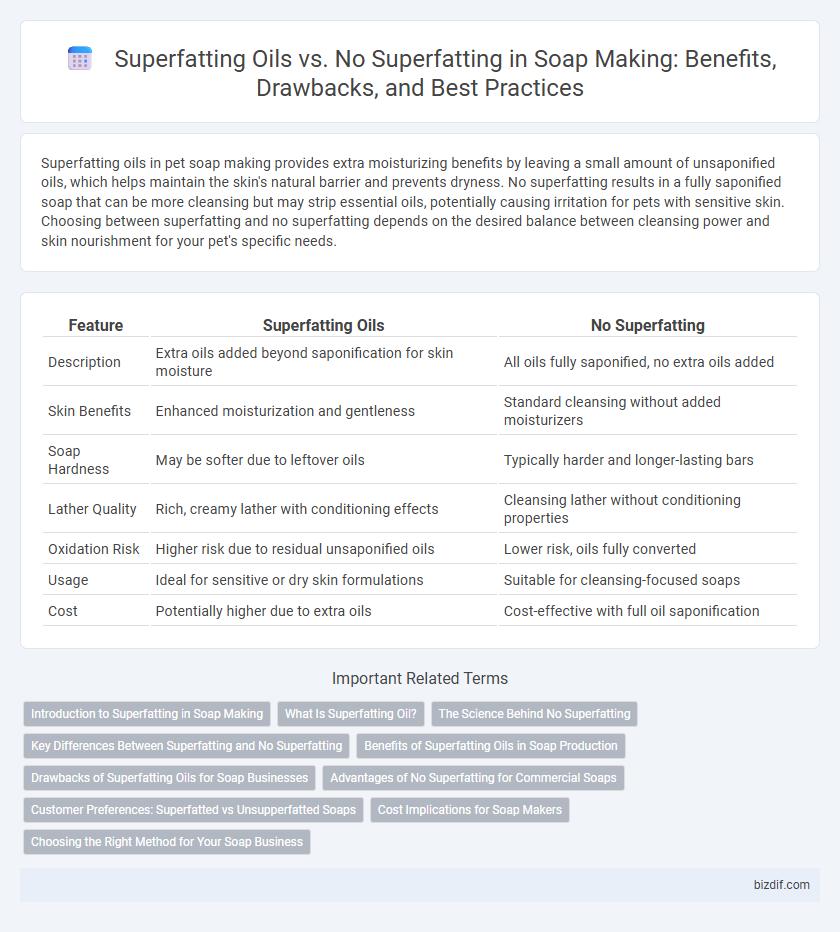Superfatting oils in pet soap making provides extra moisturizing benefits by leaving a small amount of unsaponified oils, which helps maintain the skin's natural barrier and prevents dryness. No superfatting results in a fully saponified soap that can be more cleansing but may strip essential oils, potentially causing irritation for pets with sensitive skin. Choosing between superfatting and no superfatting depends on the desired balance between cleansing power and skin nourishment for your pet's specific needs.
Table of Comparison
| Feature | Superfatting Oils | No Superfatting |
|---|---|---|
| Description | Extra oils added beyond saponification for skin moisture | All oils fully saponified, no extra oils added |
| Skin Benefits | Enhanced moisturization and gentleness | Standard cleansing without added moisturizers |
| Soap Hardness | May be softer due to leftover oils | Typically harder and longer-lasting bars |
| Lather Quality | Rich, creamy lather with conditioning effects | Cleansing lather without conditioning properties |
| Oxidation Risk | Higher risk due to residual unsaponified oils | Lower risk, oils fully converted |
| Usage | Ideal for sensitive or dry skin formulations | Suitable for cleansing-focused soaps |
| Cost | Potentially higher due to extra oils | Cost-effective with full oil saponification |
Introduction to Superfatting in Soap Making
Superfatting in soap making involves adding extra oils or fats beyond the amount needed to react with lye, resulting in a more moisturizing bar with increased skin benefits. Using superfatting oils like olive or shea butter enhances the soap's conditioning properties and reduces potential dryness. In contrast, no superfatting yields a harder, longer-lasting soap but may be less nourishing for sensitive or dry skin types.
What Is Superfatting Oil?
Superfatting oil is the extra oil added to soap recipes beyond what the lye can saponify, ensuring a moisturizing and skin-nourishing bar. This excess oil remains unsaponified, providing natural emollients that enhance the soap's gentleness and prevent dryness. Choosing superfatting oils like olive, coconut, or avocado oil improves the overall conditioning properties and lather quality of handmade soap.
The Science Behind No Superfatting
No superfatting in soap making involves allowing all the oils to fully saponify by precisely balancing lye and oils without excess fats remaining. This chemical process ensures that sodium hydroxide reacts completely with triglycerides, producing soap with minimal free oils, resulting in a harder bar with reduced moisturizing properties. The absence of superfatting limits unreacted oils, which affects the soap's lather quality and skin conditioning characteristics.
Key Differences Between Superfatting and No Superfatting
Superfatting oils in soap making involves adding extra oils that remain unsaponified, enhancing moisturizing properties and skin nourishment. No superfatting results in a fully saponified soap, offering a firmer texture but potentially drier skin feel. Key differences include skin hydration levels, soap hardness, and the balance between cleansing and moisturizing effects.
Benefits of Superfatting Oils in Soap Production
Superfatting oils in soap production enhances moisturization and skin conditioning by leaving a layer of unreacted oils on the skin, preventing dryness. These extra oils boost the soap's mildness and reduce the risk of irritation, making it suitable for sensitive skin types. Incorporating superfatting oils also improves the soap's lather quality and overall longevity, promoting a luxurious and nourishing cleansing experience.
Drawbacks of Superfatting Oils for Soap Businesses
Superfatting oils in soap making increase raw material costs and can lead to inconsistent product quality due to excess oils that may affect soap hardness and shelf life. Higher oil content often results in reduced lathering and can cause the soap to become greasy, which may deter customers seeking a cleaner rinse. Managing superfatting levels requires precise formulation expertise to avoid waste and maintain profitable production margins.
Advantages of No Superfatting for Commercial Soaps
No superfatting in commercial soap production enhances shelf life by reducing excess oils that could accelerate rancidity, ensuring consistent product stability. This method prevents sticky or greasy residue on the skin, appealing to customers seeking a clean, non-oily finish. Eliminating superfatting streamlines production processes and reduces raw material costs, optimizing profitability for soap manufacturers.
Customer Preferences: Superfatted vs Unsupperfatted Soaps
Customer preferences for superfatted soaps center on the enhanced moisturizing benefits due to extra oils left in the soap, providing a gentler, more skin-nourishing experience. Unsupperfatted soaps appeal to those seeking a cleaner, more traditional feel, with minimal residual oils, offering a firmer bar and longer-lasting lather. The choice between superfatted and unsupperfatted soaps often depends on individual skin types, with sensitive or dry skin favoring superfatted options for their emollient properties.
Cost Implications for Soap Makers
Superfatting oils increase the overall cost of soap production since extra oils must be purchased and incorporated beyond the saponification requirement. Choosing no superfatting reduces raw material expenses by fully converting oils into soap, but may result in a harsher final product lacking moisturizing properties. Soap makers must balance budget constraints with product quality when deciding between superfatting and no superfatting methods.
Choosing the Right Method for Your Soap Business
Superfatting oils in soap making enhances moisturizing properties and creates a softer bar, appealing to customers seeking skin-nourishing benefits. Opting for no superfatting results in a harder, longer-lasting soap with less oil residue, suitable for clients prioritizing cleanliness and durability. Selecting the right method depends on your target market's preferences and the balance between moisturizing qualities and soap longevity for your business.
Superfatting Oils vs No Superfatting Infographic

 bizdif.com
bizdif.com